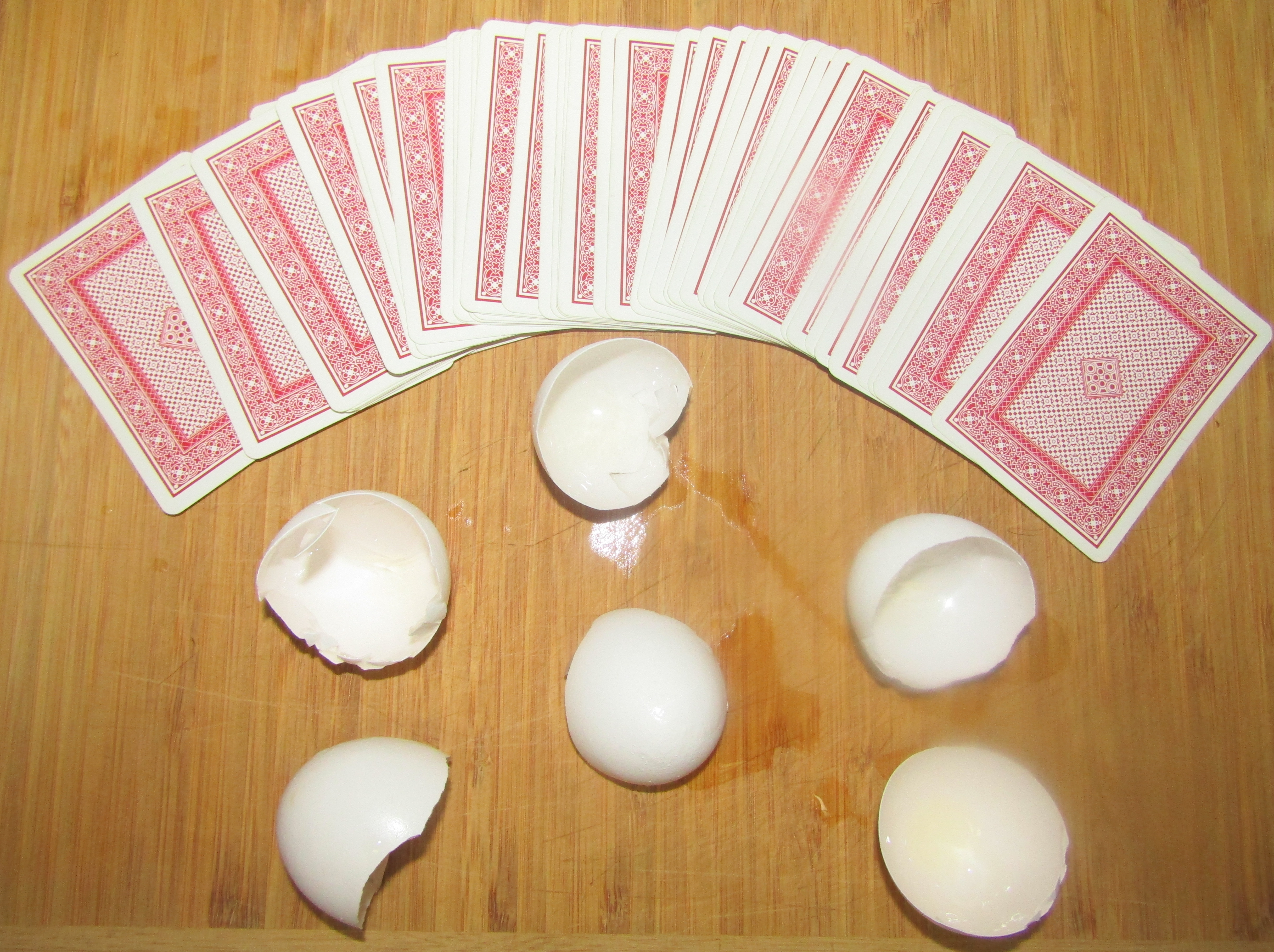 Guan Dan is a climbing/shedding type game from China designed for play by four participants in two partnerships and has a number of similarities to several other Asian climbing games. The name of the game translates in English to Throwing Eggs.
Guan Dan is a climbing/shedding type game from China designed for play by four participants in two partnerships and has a number of similarities to several other Asian climbing games. The name of the game translates in English to Throwing Eggs.
The game is played used two standard 52 card decks shuffled together with the addition of four total Jokers, for a total number of cards in the deck being 108. The normal ranking of the cards as used in the game is as follows (from highest to lowest): Colored Joker, Black and White Joker, Ace, King, Queen, Jack, 10, 9, 8, 7, 6, 5, 4, 3, 2, Ace. It should be noted that in addition to being the third highest ranked card in the deck, it is also listed as the lowest ranked as it can be used in special sequence plays, in such sequences consisting of the Ace, two, and three.
Determination of partnerships and the player to have the first turn can be performed using a variety of methods, such as draw for high cards. Using this method, each player would draw one card from a shuffled deck. The players drawing the two highest cards would play as partners against the two players drawing the two lowest cards. Any players drawing cards of the same ranking would set that card aside and draw another card, continuing until drawing a uniquely ranked card. On the first hand of the game, the player who draws the highest card can be set as the dealer for the first hand of the game. Thereafter the identity of the dealing player will be determined by the outcome of the previous hand. Players should be seated at the table directly across from their partner.
The player to have the first turn, on the first hand is also determine in a random manner. The dealer of the hand thoroughly shuffle the deck. After this shuffle, he hands the face-down deck to the player at his immediate left who flips over the top card of the deck (setting it face-up) and then cuts the deck, placing the bottom cut portion on top of the top portion. In addition to cutting the deck this will also result in the exposed card appearing someone near the middle of the deck. After this the deck is placed in a stick in the middle of the table. The dealer then draws the top card of the deck to start his hand. Each player in a counter-clockwise direction around the table draws one card. This continues until each player has a total of 27 cards to form his hand. Whichever player drew the face-up card will be the player to have the first play on this first hand.
After the first hand of the game, the rules on which specific players deal (shuffle), cut, draw first, and play first are based on the result of the previous hand (see below). On those hands, during the cut, no card is exposed in the deck, which is only done on the first hand to determine the player to have the first play of the first hand.
As noted previously, the game is designed for four players playing in two teams of two players each. Each team also starts with a ranking of "2" and attempts to, throughout the game increase their rank to eventually reach the highest rank (or level) of Ace, and then win one more hand. This level advances through the following rankings: 2, 3, 4, 5, 6, 7, 8, 9, 10, Jack, Queen, King, Ace.
The winners of the previous hand (called the "declarers" or "declaring team") and the current level of that team determines which cards in the deck have special capabilities during the hand (as played by either team). These cards are called "level cards". On the first hand, since no team won the previous hand, the level card is the two, On the second hand and beyond, however, all cards of the same rank as the current level of the declarers are thus considered to be these level cards on the current hand. The level cards in the suit of hearts are considered wild cards and can thus be used, in play, to represent any card in the deck except for a Joker. The level cards in the other three suits, are moved from their normal ranking order to be immediately above the rank of Ace (and below the black and white Jokers). As an example, say the winners of the previous hand are currently at level "5". The ranking of the cards in the deck for that hand would be as follows (high to low): Colored Joker, Black and White Joker, 5, Ace, King, Queen, Jack, 10, 9, 8, 7, 6, 4, 3, 2, (Ace). The two five of hearts cards would be considered wild during that hand and could be used as a replacement for any other card during play.
In the first hand, the player who drew the face-up card during the draw has the first play, but in subsequent hands, this will be determined by the order of wins in the previous hand (described later). The first player on a turn may play any card or combination of cards from his hand, and each subsequent player, in a counter-clockwise direction may either play a card or combination that beats the previous play or may pass. In order to beat a previous play, a player must either play a higher such combination of the same type, or play a special type of high ranked combination (called a bomb). If the current high combination played is already a bomb, he must player a higher ranked bomb (either a bomb of the same type with higher ranking cards, or a higher ranked bomb itself). If a player passes, this does not preclude him from further plays on his next or future turns. The following are all of the standard rankings that can be played by the first player to start a new series of plays:
| Number of Cards in Combination | Description | Example |
|---|---|---|
| 1 | Single Card - A single card combination consists of only one card. In comparing single card combinations, any card of a higher rank beats any lower ranked one. Any level card played in a single card combination (including in the rank of hearts) is considered one rank higher than Ace, but lower than the black and white Joker. | 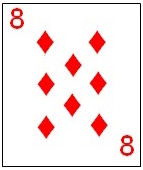 |
| 2 | Pair - A two card combination will consist of a pair of cards of the same denomination. A pair of higher denomination cards will beat that of any lower denomination. A level card in the suit of hearts can be played with any other card to make a pair equivalent to the odd card. However, two level cards is considered a pair which is one rank higher than Ace. A pair of Jokers must consist of two Jokers of the same type (such as two black and white Jokers). | 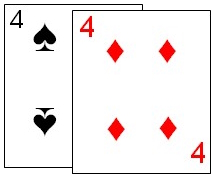 |
| 3 | Triple - This combination consists of three cards, all in the same denomination. Three cards of a higher denomination beat a triple of a lower denomination. Level cards can be combined with other cards to create a triple of the denomination of the odd card or cards. Triples containing Jokers are not possible. | 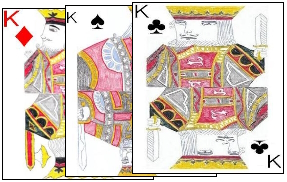 |
| 5 | Full House - A full house combination consists of five cards, arranged such that the combination contains one pair and one triple. In comparing two such combinations, the highest triple is considered the higher. As with a triple, wild level cards can be used to form either the triple or the pair, and a triple consisting of any three level cards is the highest ranked full house. | 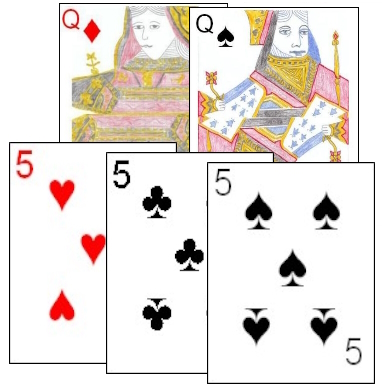 |
| 5 | Straight - This combination consists of five cards which are in a direct numerical sequence and of mixed suits. The ranking of the sequence should be in the normal, base ordering, regardless of what the current level cards are. However, a wild level card can be used as replacements for any normal card. As mentioned previously, the Ace can be used as a low card (before the two) in such a straight, or can be used as a high ranking card after the King. Straights may never include any Jokers. In comparing two such straights, the highest is considered that with the highest top card in the straight, using the normal ranking (regardless of the current level card). | 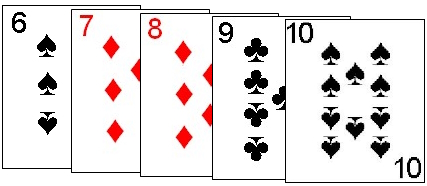 |
| 6 | Tube - A tube consists of six cards, which consists of three consecutive pairs. If the tube contains three non-wild level cards, these cards are considered to have their normal, natural ranking for purposes of proper sequencing and ranking amongst other tubes. In comparing two such combinations, the tube containing the highest top pair is considered the highest. As with a straight, level cards included in the straight are considered to retain their normal (non level card) ranking as regards to use in a tube and comparing tubes. However, a level wild card can be used to represent any other card in the combination. | 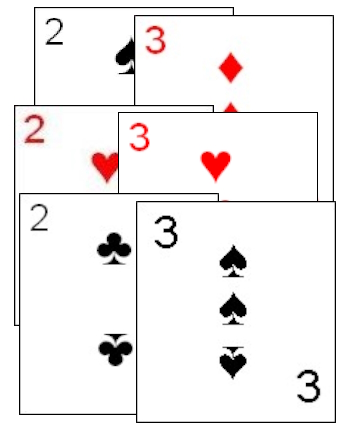 |
| 6 | Plate - A plate is a combination consisting of two contiguous triples. Non-wild level cards are considered to have their normal, natural ranking for use in a plate. In comparing two plates, the combination with the highest ranking triple is considered the higher. Wild level cards can be used to form any of the cards in the triple, taking on the value of the replaced card. | 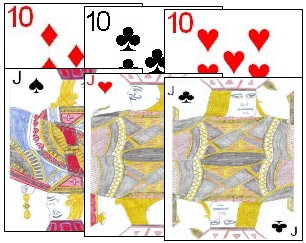 |
In addition to the normal combinations, there are also several special combinations, called bombs. Any bomb can beat any normal combination. In comparing two different bombs, a bomb can be beat by any higher ranked bomb, or a bomb of the same type, but which contains higher ranked cards. The following are the types of bombs that can be played, along with the ranking of that bomb (lowest to highest):
| Ranking of Bomb | Combination Description | Example |
|---|---|---|
| 1 | Quadruple - A quadruple is four cards of the exact same rank. "Wild" level cards can be used to replace one or two such cards found in the combination. For comparing two quadruples, the quadruple containing the highest ranked cards (using the natural order ranking) is considered the higher, with a quadruple consisting of any four level cards considered the highest quadruple of all. | 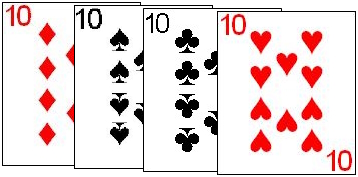 |
| 2 | Quintuple - A quintuple bomb is five cards, all of the same rank. "Wild" level cards can be used to replace up to two of the cards found in the combination. For comparing quintuples, the quintuple that consists of the highest ranked cards (in the natural order) is considered the highest, with a quintuple consisting of any five level cards considered the highest such quintuple of all. | 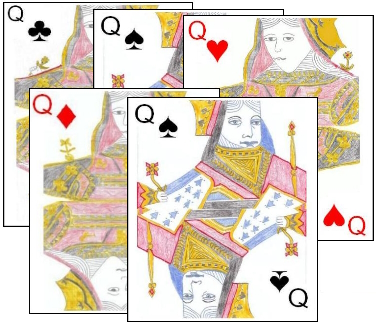 |
| 3 | Straight Flush - This bomb consists of five cards in direct sequential order and all of the same suit. For purposes of the use of level cards, non-wild level cards are considered to be in their natural ranking, however wild level cards can be used to replace any cards in the bomb. As with straight, if an Ace is included in the straight (if not a level card), it can be the highest such card in the straight flush (next above King) or the lowest (before 2). If comparing two such straight flush bombs, the highest is that which has the highest top card. | 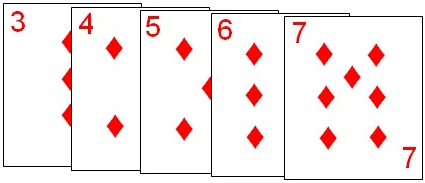 |
| 4 | Sextuple - A sextuple is six cards, all of the same rank. "Wild" level cards can be used to replace up to two of the cards found in this combination.. | 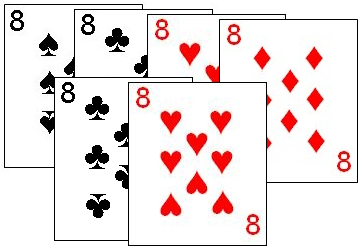 |
| 5 | Septuplet - A septuplet consists of seven cards, all of the same rank. "Wild" level cards can be used to replace up to two of the cards used to form this combination. | 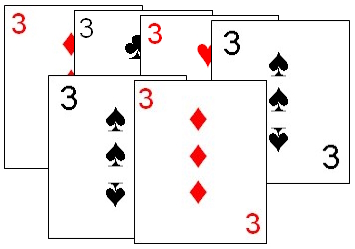 |
| 6 | Octuplet - An octuplet consists of eight cards, all of the same ranking. "Wild" level cards can be used to replace one or two of the cards used to form this bomb combination. | 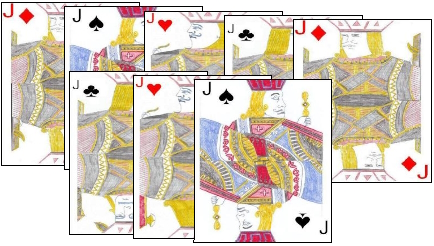 |
| 7 | Nonuplet - A nonuplet consists of nine cards, all of the same rank. By necessity, this combination will include at least one "wild" level card, but may contain both such wild level cards, representing two such non-wild cards in that combination. | 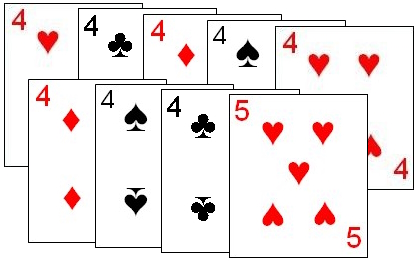 |
| 8 | Decuple - A decuple consists of ten cards, all in the same rank. This combination will consist of eight cards of the exact same rank and the two wild level cards being used to represent the same rank as the eight naturally ranked cards. |  |
| 9 | Four Jokers - This, which is the highest bomb in the game, consists of all four Jokers in the deck (two colored Jokers and two black and white Jokers). This bomb may never include any level cards. | 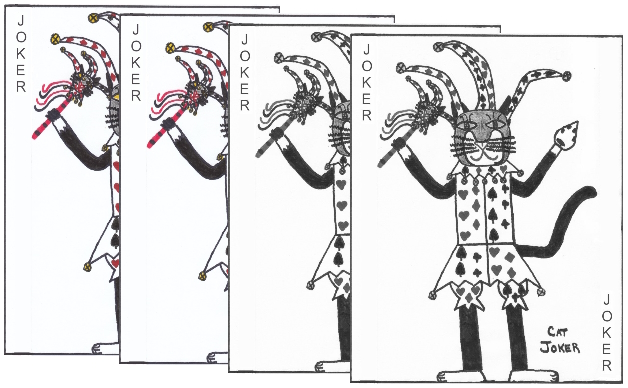 |
When a combination is played that contains any wild cards, the player of the combination must state what natural cards the wild cards are representing.
If any play is followed by three consecutive passes, the previous played cards are all cleared from the table and set aside, out of play. The last player to make a legal play, may then start a new series of plays with any valid combination from his hand.
Once a player plays the last of his cards, he is considered the first winner of that hand. He then drops out of the hand, and the remaining three players continue play as normal, continuing with the next player in turn from the first winning player. These three players play similarly as before, with any play that is followed by two consecutive passes ending the current series, allowing the last player to make a player to start a new series of plays. These players continue until yet another player manages to legally play his last card, with this player also dropping from the game. The last two players then continue play, with any pass allowing the other player to start a new series of plays. Once one of these last two players manages to play his last card or cards, the hand ends, and the winning team will then have the opportunity to advance one or more levels. The team which consists of the first player to deplete his hand is considered the winners, however the number of levels that team advances is based on the finishing order of the second member of that team:
- For a team in which their finishing order is first and last, that team advances one level.
- For a team that has a finishing order of first and third, that team advances two levels.
- For a team finishing first and second, that team advances four levels.
 |
The winning team on that hand also automatically becomes the declarers for the next hand, and the opposing team members are set as the opponents. In addition, on the next hand, the losing team must, in most cases, provide tribute to the winning team. If the winners end with a finishing order of first and second, the opponents much each give their highest card (but never a wild card) to the winning team. These cards are placed face up on the table, with the highest card going to the player who finished first and the second highest of these cards going to the player who finished second. In exchange, the players taking these cards, pass any card from their hand (also face-up) back to the player who's card they took. If, amongst the opponents they have both Colored Jokers, they can, however, show these cards which cancels any tribute required on that hand. For a team that finished first and third, or first and last, the player who finished last (who may be an opponent or the player's partner) must pass his highest card (excluding a wild card) to the player who finished first. He passes this card face-up, such that every player can see the card. In exchange for this passed card this player passes any card of his choice from his hand back to that player. However, if this player from whom tribute is required has both colored Jokers, he may show these cards and the tribute is thus canceled for that hand. All cards are passed face-up such that every player can see the cards as passed and the same card may never be passed back.
For each hand after the first, the player who finished first shuffles the deck, the player to that player's immediate left cuts (not exposing a card as was done in the first hand of the game), and the player finishing last draws the first card in that hand. The player to have the first turn in the hand is the player who provided the highest card for tribute in that last hand. If two cards were provided for tribute, and both were of equal value, these two players can decide amongst each other who should lead, and if unable to decide, can each draw for high cards from a shuffled deck to determine this. If no tribute was provided (as the colored Jokers were shown), the first lead on the next hand is made by the player who was first to finish on that last hand.
The objective of the game is to, once a team advances to Ace, to then Advance once more. However, there are certain rules required to advance to become the winners of the game:
- A team must be at level Ace, be the declarers, and then win a game, specifically in finishing order of first and second or first and third, in order to then be declared the winning team.
- If a team is at level Ace, are the declarers, and then win the game in a finishing order of first and last, they remain at level Ace and remain the declarers for the next hand.
- A team at level Ace and are the current declarers, but does not win the hand, simply becomes the opponents, and the opposing team become the declarers for the next hand.
- If a team is at level Ace, but are not the declarers, and wins the game (in any finishing order), that team remains at level Ace, but they become the declarers for the next hand.
- If a specific team has been at level Ace, and been the declarers for three consecutive hands, but have not yet managed to win, after that third attempt, that team is immediately set all the way back to level 2.
- If a specific team, at level Ace and the declarers, is beat by the opposing team, and the last play by the player finishing first on that hand, consisted of Aces (one or more) and no other cards (including wild cards), that team is set all the way back to level 2.
- If a team is at any level less than Ace, and wins such as to advance enough levels that would bring them past level Ace, they simply stop at Ace, and must then win, with the above criteria.